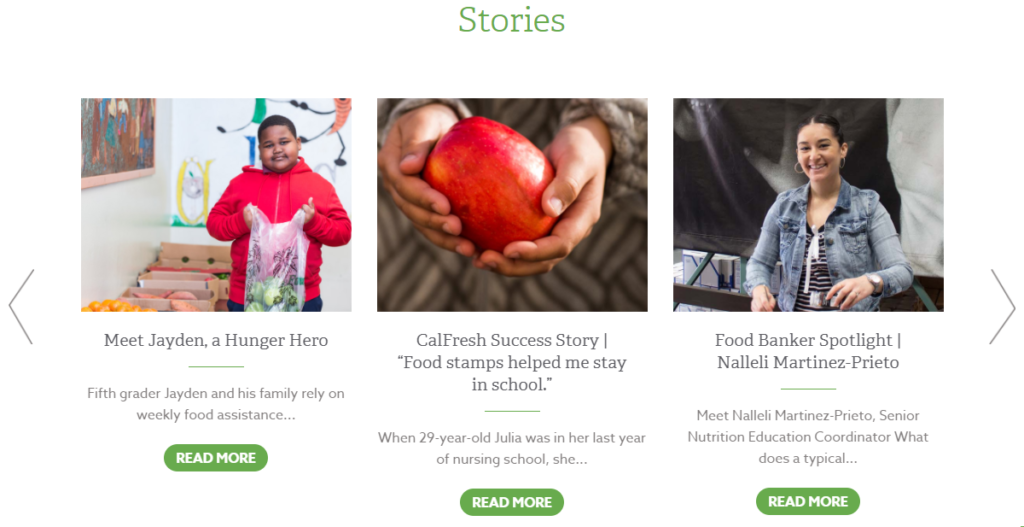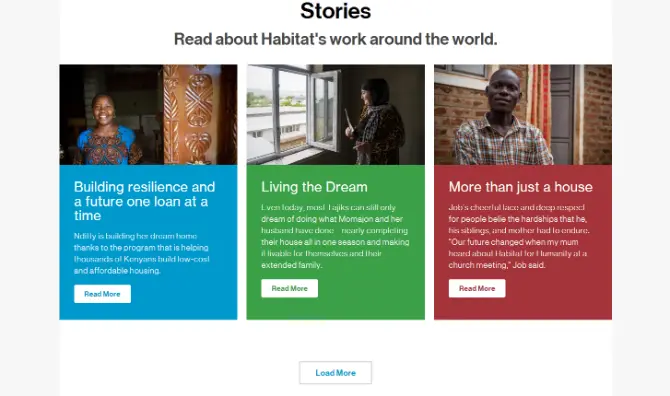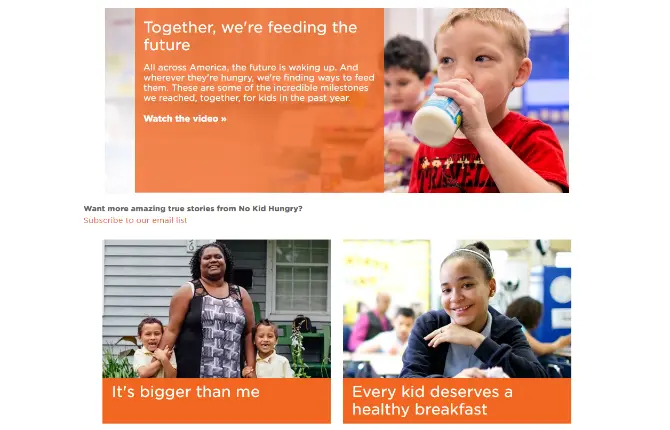When we talk about nonprofit storytelling in your marketing, we’re talking about using real stories about real people who were or are in need of something that your nonprofit can provide them. Stories pack emotion, and people act on causes that make them feel something. Using more stories in your nonprofit marketing will engage your audience and inspire new supporters to get involved.
The power of one identifiable person you can help will beat out any larger, unnamed or statistical group of people that may seem beyond your ability to help.
Supporters like to see how their contribution fits into the big picture. Using numbers and statistics can be overwhelming, but zeroing in on one example through nonprofit storytelling brings clarity and helps supporters see what they’re working for when they partner with your nonprofit.
Let Your Stories Tell Themselves
Whenever possible, nonprofit storytelling best practices will advise you to let your constituents and supporters tell their own stories. They’ll come off a lot more powerful. Think about it: you want these stories to pack emotion, so keeping them in the words of the person who actually experienced the emotions you’d like to invoke in your supporters makes a whole lot of sense.
Show Impact
Show the readers everything, tell them nothing.
Ernest Hemingway
Ever heard the phrase “show, don’t tell” come up in a discussion on writing techniques? There’s a good reason. Sharing your impact through stories of those you’ve helped gives a more personal and much stronger message to potential supporters as well as those in need of your help.

The San Francisco Marin Food Bank pulls inspirational stories of constituents and volunteers onto their Our Impact page to show their impact. Introducing young Jayden and his family is a lot more compelling than simply stating something like, “we provide food for hundreds of children.” Your reader may not know any of those children, but now they know Jayden and can better relate to your mission.
Give Detail
Does your character have children? Dreams? Goals? What obstacles are in their way? It’s the little things. A father with a daughter on her way to college may cling to a detail of a similar young girl looking to do the same, but desperate for a scholarship. We look for connections to our own life and the people we love everywhere, usually without even realizing it. And we find them in the details.

Habitat for Humanity, Europe, Middle East and Africa shares detailed stories of the families they help to strengthen their Our Impact section. Job Kalulu’s story, More Than Just a House is a great example of that tactic, describing how he and his siblings would sleep under the bed to escape a leaky roof before their new home was built. Rainy nights are calming for many people, but not for those with leaky roofs. It was that detail that made the whole of this family’s living situation resonate with me.
Use Video
Videos are engaging. And, when done right, video is an extremely powerful form of storytelling that puts a face and a voice to your impact. It’s much easier to say no and ignore a problem when it’s not staring you in the face and asking you for help. Use video to show your community or those that you’re helping and let them speak for themselves about the impact your organization has had on their lives.
In the video “For Whitney,” Barbells for Boobs inspires new supporters to get involved and continue their mission — all through one woman talking about her personal experience and what led her to take action. You won’t be able to ignore the tears in her eyes, the tremor in her voice or the strength in her demeanor.
Offer a Solution
When it comes to inspiring action, people are more likely to act on a problem that seems manageable. You need to do more than connect the people to an individual and let them know that there’s a problem affecting him/her. You need to provide a solution to the conflict in your story that moves your mission forward. Through storytelling for nonprofits, you empower donors to be a part of the story, i.e. a part of the solution and happy ending. When they see that their help can make a difference in this one person’s life, they’ll be much more likely to step up and do something.

On its No Kid Hungry microsite, Share Our Strength offers a “slice of life” storytelling experience into the lives of the kids they’re helping. Posing the problem with the seemingly simple solution of a few dollars for meals, they use photos, video and quotes from their kids to pull at your heartstrings and inspire you to help a hungry kid.
Include Short Stories Everywhere
Long-form stories are awesome for blog posts and email newsletters, but storytelling is more versatile than that. The best nonprofit storytelling includes shorter, 3-5 sentence stories spattered throughout your website content, on social media and wherever else you can slip them in.

Operation Groundswell does a great job of this on their “What to Expect” page, weaving moving testimonials from past program participants into their content. But such stories can also be woven into content on your history, programs, impact, about us and get involved pages. Really, you can work nonprofit storytelling in anywhere and everywhere.
Supporters care more about your cause than your organization, and that should be clear in your content. Stories paint a picture and keep your target audience engaged and emotionally connected to your cause and the work that you’re doing to move it forward. Include as many as you can to see those benefits grow exponentially, along with your number of supporters.
How does your nonprofit use storytelling? Have any inspirational stories to share? Comment below. We’re always looking to be inspired!
What You Should Do Now
01. Come to Nonprofit Website Office Hours
We cover a new topic every few weeks. Plus get a live answer to any website-related question you're wrestling with.
02. Book a Website Call
Find a time to discuss your nonprofit's website needs. Discover what's worked for other nonprofits like you and see how easy building your new site can be.
03. Start a Free Website Trial
Try our nonprofit website platform for yourself. Instantly get access to every feature to see if it's the right fit for your needs. No credit card required.

Hi Christine,
Do you write/ re-write technical Case studies to become storytelling Case studies. I will provide report story and power point presentation to develop Case study
Thanks for reaching out, Judy! We don’t typically accept one-off projects at Wired Impact, preferring to partner with our clients in the long term to move their marketing forward in a more substantial way. Check out the details of what an ongoing partnership with us might look like, and reach out through our Contact Us form.